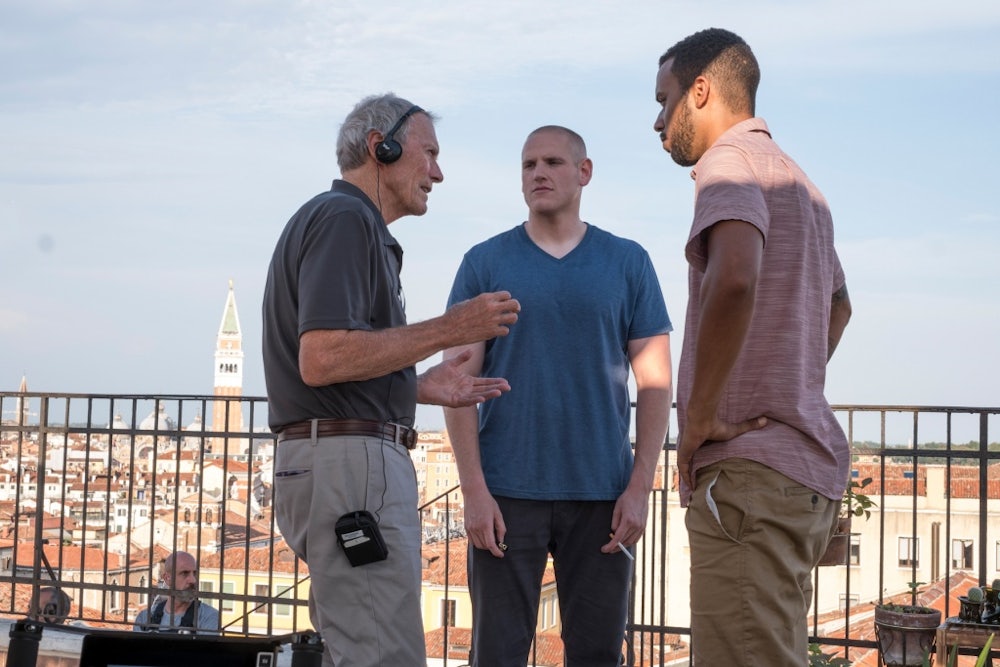Clint Eastwood’s new movie is called The 15:17 to Paris. The title refers to a train that in 2015 was traveling from Amsterdam to Paris. On the train were 300-odd people, including three American friends named Spencer Stone, Anthony Sadler, and Alek Skarlatos. Stone and Skarlatos were off-duty servicemen, Sadler their childhood playmate. Also on board was Ayoub El Khazzani, a man from Morocco who went into the toilet and then emerged from it shirtless but holding an assault rifle. He also carried a boxcutter and a handgun and a lot of ammunition. Khazzani would claim to to be hungry and homeless, seeking to rob passengers, but prosecutors interpreted his crime as one of terror based on his internet use. The first man to resist Khazzani was a Frenchman known only as Damien A.—he fell to the ground. The second man to throw himself at Khazzani was shot and injured badly—his name was Mark Moogalian. Then Stone barreled toward him. Khazzani tried to shoot him with his rifle, but it didn’t go off. Stone, Sadler, and Skarlatos restrained Khazzani, knocked him out, then Stone tended to Moogalian’s neck wounds.
That is the whole premise of the The 15:17 to Paris. The climactic train sequence is heroic and thrilling, but it lasted only a few minutes in each of its participants’ lives. So, Eastwood has had to reach deeply into cinema’s bag of tricks to flesh the story out into a movie. His major “move” has been to cast the real participants in this real-life drama in the film: Stone, Sadler, Skarlatos, Moogalian, and Moogalian’s wife all play themselves. This means that Moogalian reenacts the moment where he lay on the ground and bled from an artery in his neck. His wife reenacts her pleas to her husband that he stay with her in this life. Khazzani does not play himself, of course, nor do we learn anything about his unclear motives.
It also means that Stone, Sadler, and Skarlatos have re-lived a few minutes of action, informed by reflexes and training, as 94 minutes that reposition the rest of their lives as inevitably leading up to that moment. They as a group are the heroes of the film, but Stone takes the lead role.
We begin with childhood. Stone is a mischievous kid, forever getting in trouble with his partner in crime, Skarlatos. The pair is obsessed with guns and war. Stone has a closet full of imitation weapons. I’m not sure it’s supposed to be disturbing to watch the friends—plus Sadler, once they meet him outside the principal’s office—shoot at each other in a war game in the woods, but it is. Judy Greer and Jenna Fischer play Stone’s and Skarlatos’s mothers throughout the movie. Both are good actresses, but I had to cover my eyes during an abominably scripted scene at the boys’ school. A teacher suggests that the kids have ADHD. Greer storms out, announcing, “My god is bigger than your statistics.” Spencer Stone is also religious. Throughout the movie, the war-obsessed boy turned soldier un-ironically prays for God to “make me an instrument of your peace.”
Suddenly grown men, Skarlatos joins the U.S. Army National Guard. Stone announces that he wants to sign up for the U.S. Air Force Pararescue, but his friends don’t believe he has what it takes. A large chunk of the movie then focuses on Stone’s transformation into a fit and committed serviceman. There is even a training montage, complete with flipped tires and circuit runs. Needless to say, Stone makes it into the armed services, though he can’t see well enough for his dream job.
Fast-forward a little, and the three men are on vacation in Europe. Sadler has a selfie stick. They act like moronic American tourists, which is embarrassing to watch, and then, at long last, they get on a train.

Eastwood’s decision to cast the real-life men in his movie version of their lives produces a number of extremely strange effects. First, they are not actors. And so, even as they try to reproduce a relaxed banter between them (hungover after a night out), none of the three main characters can deliver their own lives—that is, replicating things that they have already done—up on screen “naturally.” Of course acting is not the same as living. Nevertheless, the result is bizarre. Skarlatos is the worst actor by far and Sadler the best. Stone merely gazes straight ahead and reads his lines. They’re all handsome but just appalling actors. This disjuncture is impossible to forget while watching the film, and it’s very uncomfortable.
At the end of the movie, François Hollande presents the three with the Légion d’Honneur. Of course, Eastwood could not enlist Hollande to reenact a speech he had already given, this time in a movie. Instead, he has spliced actual footage of the ceremony with acted scenes. The three leads appear in both. They wear the same clothes, each in an ugly polo shirt. On one tape they look very slightly younger, on another very slightly less comfortable. The awkwardness is emphasized further by the presence of actual actors. Real family members appear in one tape, and the acting moms in another—Greer and Fischer are both “present” at the ceremony. The effect is downright uncanny, as if we were watching a movie where the actors are glitchy robots.
Once you’re weirded out enough to start thinking laterally, The 15:17 to Paris becomes an interesting viewing experience about Clint Eastwood himself. The little boys playing with guns in the forest are like microscopic clumps of violent American masculinity, the kind that Eastwood’s roles in Hang ‘Em High, Dirty Harry, and High Plains Drifter helped formulate.
Then the realization dawns that this movie is a sort of fusion of Eastwood’s other recent directorial projects, Sully (2016) and American Sniper (2015). The former also dramatized an amazing moment in which the right American had the right skills at the right time to save a lot of people. The latter was also about a singular hero with military prowess, but it was violent and bloody, part of Eastwood’s broader project of directing military films—Firefox (1982), Heartbreak Ridge (1986), Flags of Our Fathers (2006), Letters from Iwo Jima (2006).
Eastwood has taken on a strange public role in his later years. He is a politician in his own right, having been mayor of Carmel-by-the-Sea, California; he campaigned against gun control; and of course, he entered national politics in grand style when he addressed the empty chair of Barack Obama during the 2012 Republican National Convention. One of the few openly conservative Hollywood celebrities, his politics and weird performances have given him the air of a crank.
So, the identities of Clint Eastwood as a man who loves the U.S. military, as a man obsessed with blessed coincidences, and as a deeply weird individual all come together in The 15:17 to Paris. The film is so surreal that it’s worth watching, if only for its unsettling and counterintuitive style—and the big screen debut of one François Hollande.
